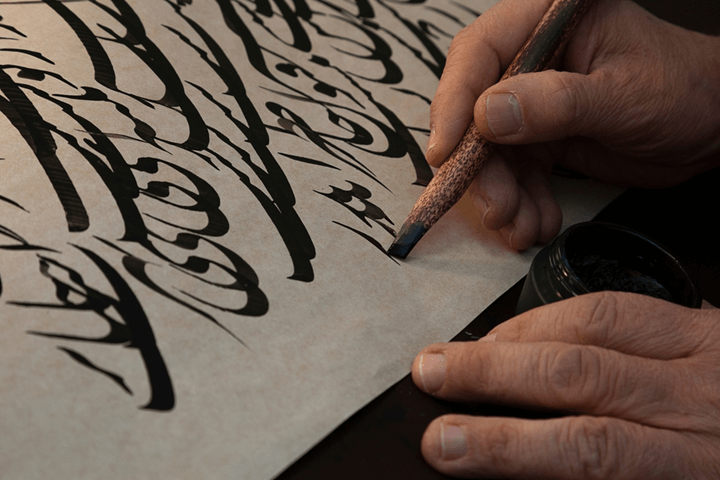The Arabic script is one of the most elegant and widely used writing systems in the world. Its flowing lines and intricate forms have captured the hearts of poets, scholars, and artists for centuries. But the journey of the Arabic writing system is a fascinating tale of evolution, from a spoken tradition to a meticulously crafted script. This article will take you back in time to explore the Arabic alphabet origin, its remarkable Arabic alphabet evolution, and its enduring legacy.
Preserving the Past: Oral Tradition Before the Written Word
Before the widespread use of a refined Arabic writing system, ancient Arabs relied on a powerful tradition to pass on history and knowledge. So, how was history passed on to future generations before the written language of Arabic was introduced?
The answer lies in oral tradition. The Arabs were masters of memory, poetry, and storytelling. History, genealogy, and cultural values were preserved through:
- Poetry (الشعر – Ash-Shi’r): Poets were revered figures, and their verses, which could be memorized by thousands, served as historical records. The famous pre-Islamic “Hanging Odes” (المعلقات – Al-Muʿallaqāt) are a testament to this tradition.
- Storytelling (الحكاية – Al-Hikāyah): Tales of heroes, battles, and tribal histories were passed down from generation to generation by skilled storytellers.
- Genealogy (الأنساب – Al-Ansāb): Preserving family lineage was a matter of great importance and was meticulously memorized.
This vibrant oral culture ensured that history and knowledge survived for centuries before the advent of a standardized written script.
The Arabic Alphabet Origin: A Family Tree
The history of the Arabic alphabet is not an isolated story; it’s part of a larger linguistic family. The Arabic alphabet origin can be traced back to the Nabataean script. The script itself evolved from the Aramaic script (a prominent Semitic language). The Nabataeans were an ancient Arab people who built the city of Petra in modern-day Jordan. Their script, which was more cursive than its predecessors, laid the groundwork for the Arabic script we know today.
The Evolution of the Arabic Alphabet: From Simple Marks to a Refined Script
The Arabic alphabet evolution was driven by necessity and innovation. The early script was quite basic, lacking the dots and vowel marks that are so common today.
- Early Scripts and Ambiguity: In the early Islamic period, the script was un-dotted and un-vocalized. For example, the letters ب (bāʾ), ت (tāʾ), ث (thāʾ), ن (nūn), and ي (yāʾ) looked almost identical. This ambiguity was not an issue for native speakers who relied on context, but it became a problem as Islam spread to non-Arab regions.
- The Dotting System (I’jām): To solve this, dots (إعجام – iʿjām) were introduced in the late 7th century CE to differentiate between letters. For example, a single dot below made the letter ب, two dots above made it ت, and three dots made it ث.
- Vowel Marks (Ḥarakāt): The final major stage in the history of the Arabic alphabet was the introduction of short vowel marks (حَرَكَات – ḥarakāt). This was primarily done to ensure the correct recitation of the Quran and to eliminate any remaining ambiguity.
- Fatha ( َ ) for a short ‘a’ sound.
- Kasra ( ِ ) for a short ‘i’ sound.
- Damma ( ُ ) for a short ‘u’ sound.
- These diacritics were standardized and added to the script, making it a complete phonetic system, especially for religious texts and for learners.
This gradual Arabic alphabet evolution transformed a beautiful but ambiguous script into a clear and precise tool for preserving knowledge and faith.
From Script to Art: Calligraphy’s Timeless Beauty
With its refined form, the Arabic writing system became more than just a means of communication; it became a revered art form. Islamic calligraphy developed into various styles, from the angular Kufic script to the elegant Naskh and flowing Thuluth. It adorned mosques, architecture, and manuscripts, becoming a primary expression of Islamic art.
The journey of the Arabic writing system is a testament to the Arab world’s dedication to knowledge, art, and the preservation of culture. It evolved from a tool for a few to a universal script, carrying with it a history as rich and profound as the civilization it represents.
Ready to begin your journey with the Arabic writing system and beyond? Visit www.kaleela.com and download the Kaleela Arabic learning app today! Our interactive lessons are specifically designed to help non-native speakers master the Arabic alphabet and connect with the rich Arab culture and its history.



